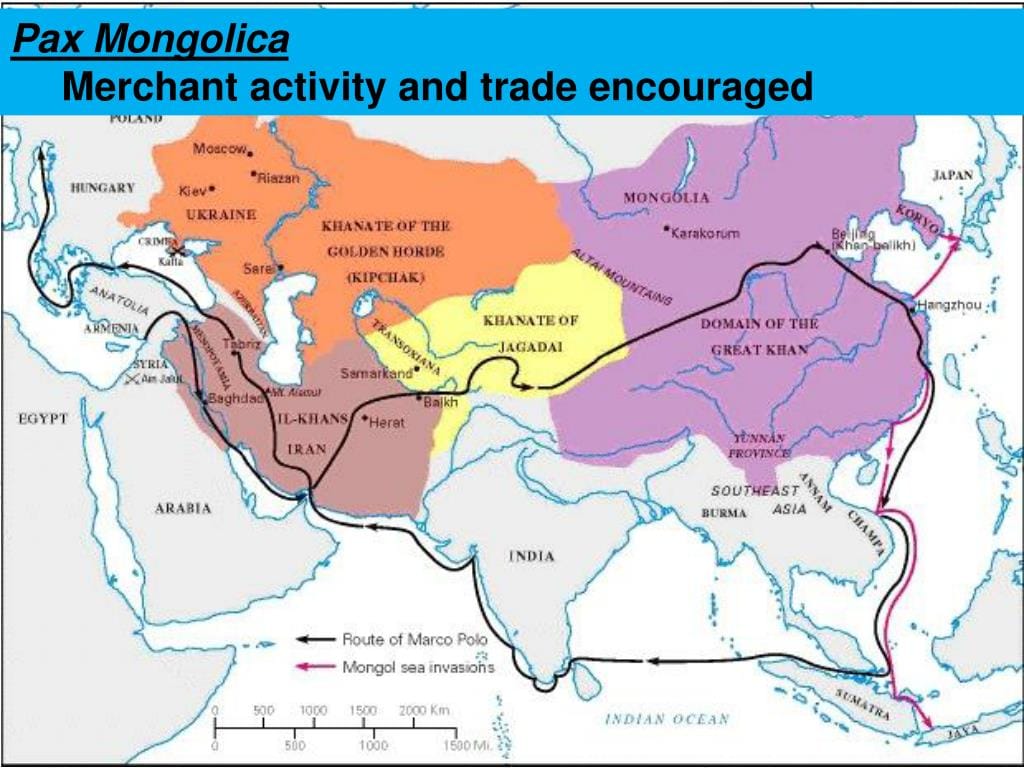The 13th and 14th centuries witnessed the rise of the largest contiguous land empire in history: the Mongol Empire. This period, known as Pax Mongolica, was marked by a relative peace and stability that facilitated unprecedented cultural exchange and trade across Eurasia. As merchants traversed newly established routes like the Silk Road, they unknowingly carried a silent and deadly passenger: the Black Death. This article delves into the complex relationship between Pax Mongolica and the Black Death, exploring how Mongol rule inadvertently set the stage for one of the most devastating pandemics in human history.
The Rise of Pax Mongolica: From Conquest to Connectivity
The story of Pax Mongolica begins with the conquests of Genghis Khan in the early 13th century. Unifying previously fragmented Mongol tribes through his military prowess and innovative organizational tactics, Genghis Khan laid the groundwork for an empire that would stretch from East Asia to Eastern Europe under his successors, notably Ögedei Khan.
This period of Mongol dominance ushered in a new era of stability across Eurasia. Pax Mongolica played a significant role in the development of trade routes and cultural exchanges. The Silk Road, a network of trade routes connecting the East and West, flourished under Mongol protection. Merchants transported silk, spices, and porcelain from China to eager markets in Europe and the Middle East. In return, horses, glassware, and textiles traveled eastward. This vibrant exchange of goods facilitated a parallel movement of ideas, technologies, and people, fostering an environment conducive to the exchange and dissemination of knowledge and culture.
A Silent Threat Emerges: The Black Death
As trade flourished and interconnectedness grew, so did the silent threat of disease. The Black Death, a devastating bubonic plague pandemic, is believed to have originated in Central Asia. While its precise origins continue to be debated among scholars, it was likely carried by rodents and fleas that thrived in the bustling trading centers and along the well-traveled routes of the Mongol Empire.
The interconnectedness fostered by Pax Mongolica, while beneficial for trade and cultural exchange, inadvertently created ideal conditions for the plague’s rapid westward movement. Merchants and travelers, unaware that they harbored infected fleas on their bodies or among their goods, became unwitting agents of transmission. By 1347, the Black Death had reached Europe via ships traveling from Black Sea ports, swiftly engulfing major cities like Constantinople and Venice.
The Unraveling: How the Black Death Impacted Pax Mongolica
The Black Death’s arrival in Europe marked the beginning of a devastating pandemic that would reshape the course of history. Across Eurasia, millions perished, leaving communities devastated and economies in ruins. The plague’s impact on the Mongol Empire itself was profound.
While the Mongols were known for their military might, they proved vulnerable to this invisible enemy. The Black Death ravaged their population, with estimates suggesting that perhaps as much as 30% of the empire’s population succumbed to the disease. This loss of life, coupled with the economic and social turmoil that followed in the plague’s wake, significantly weakened the empire’s infrastructure, administration, and military might.
The empire, once seemingly invincible, began to fracture. Regional leaders, sensing weakness at the heart of the empire, began to assert their autonomy. The cohesive force of Pax Mongolica, which had held such a vast territory together, began to unravel, eventually giving way to a period of fragmentation and decline.
Echoes of the Past: Pax Mongolica and Modern Globalization
The interconnectedness that characterized Pax Mongolica finds an echo in our modern age of globalization. The story of the Black Death serves as a stark reminder that even seemingly positive developments, such as increased trade and cultural exchange, can have unintended and devastating consequences. Just as the Pax Mongolica facilitated both the exchange of goods and the spread of disease, so too does modern globalization present us with a double-edged sword.
The rapid spread of COVID-19 in our own time underscores the continued relevance of understanding historical pandemics. By studying the complex interplay between Pax Mongolica and the Black Death, we gain valuable insights into the challenges and potential pitfalls of an increasingly interconnected world. Understanding the past, it seems, is essential for navigating the present and preparing for the future.
- Star Ring Trends: Etsy vs Amazon - March 28, 2025
- Boost Pollinator Habitats: Baby Blue Eyes Sustainable Farming Guide - March 28, 2025
- Protect Big Black Bears: Effective Conservation Strategies - March 28, 2025
















